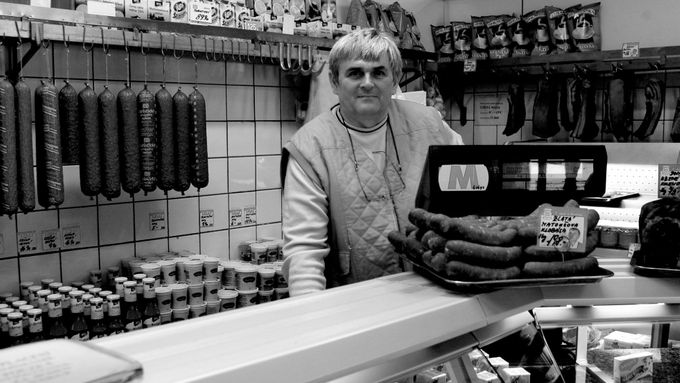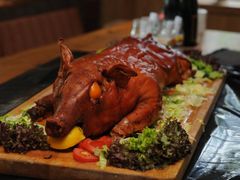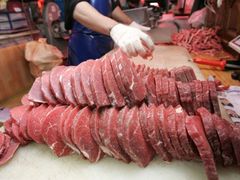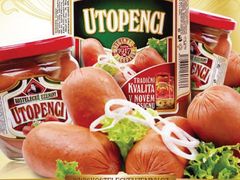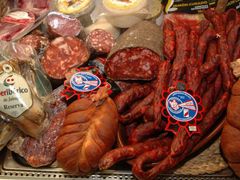Prague - With rosy cheeks as red as the pig blood splattered on his white shirt, Vaclav Klatil welcomes every customer to his butcher shop as though he were greeting an old friend. His wife and daughter stand dutifully behind the counter in starched white smocks, fetching today's sausage links and jars of pastika, or liver spread, from a cauldron of simmering water in the rear of the kitchen.
Klatil ambles to an eight-foot tall wood-burning stove, pulls open the iron doors, and examines racks of smoked prime rib hanging from hooks. He removes one of the slabs, holds it to his nose, and inhales deeply.
"If you buy meat from a supermarket like Albert, it all stinks," he grumbles. "Every piece is ugly, rotten. But not my meat-smell that!" he orders, thrusting the hunk of smoky, tender ribs at an inexpert visitor.
Czechs take their meat seriously. The menu of a traditional Czech restaurant is a veritable Noah's Ark of smoked and grilled animals: gravy-like beef goulash, whole golden ducks served on a cushy bed of potato and bread dumplings, and roasted pork knuckle are the local favorites. Rabbit, sheep, and goat meat also account for a small portion of a typical Czech's diet.
The battle over spekacky
And just last year, a battle erupted between the Czech Republic and their Slovakian neighbors over which country had the right to proclaim the spekacky-a short, greasy street sausage-as its own specialty creation. The feuding countries eventually took their duel to the European Commission in Brussels for an official settlement.
Pork plays a prominent role in a typical Czech diet. According to the most recent United States census report on worldwide meat consumption, the Czech Republic consumes, per capita, 67.7 kilograms of pork per year, more than twice as much pork per person as the United States. Only the Danes eat more pigs, devouring 73.7 kilograms of pork per person every year.

And according to statistics from the Czech Meat Processors Association, Czechs down 81.4 kilograms of meat per capita per year. This is twice as much as the world average of 43 kilograms of meat per capita, per year.
Celebrating swine
Aside from their incredible intake, Czechs now have one more reason to celebrate their swine. Klatil, representing the Czech Republic at the 17th International Competition for Meats and Sausages held in Wels, Austria, took home top honors for his klobasa sausage, as well as second and third prize for his cheese sausage and smoked ham, respectively. At the contest, Klatil beat out 21 other notoriously carnivorous countries, including Germany, Italy, and Canada.
"I was very surprised to win," he says. "I had three products in competition, and not very high hopes. The other butchers didn't think much of me, but then I swept them up!"
Klatil's shop is located in the village of Pacov, a town of 5,000 people situated exactly between the city of Prague and the northern border of Austria.
The storefront is festooned with the typical red and white checkers of a butcher shop, and small cutouts of Klatil's tiny-toothed grin crown every product in the store. He bustles with productivity from four in the morning, when he builds a fire in the wood-burning oven for his succulent ribs and smoked hams, until ten at night.
His constant attire-a red vest over white slacks and a white sweater-evokes a feeling of Christmas time, especially with the smell of broiled meat wafting through the shop.
But this Santa Claus-like butcher with the deep baritone couldn't be more different from the meat vendor that held court over customers during the days of Communist power.
Vivid memories of long lines
Despite putting twenty years between themselves and the Communist regime, Czechs still remember the endless lines that sprouted from local stores during widespread food shortages.
Zdenek Kirschner, 81, a professor of photography at New York University in Prague, still recalls standing for hours in December to purchase "yellow, unlovely-looking Cuban oranges." The same process of wait-and-see applied to butchers as well.
"The food shortage didn't mean there was no meat, but usually it wasn't what you wanted or what you preferred," says Kirschner. "In those days, it was best to know someone behind the counter, and start waiting the night before."
Milan Smid, a Czech media analyst and Charles University lecturer, suspects that the lack of food led to corruption within the retail chain, owing to the fact that the butchers were technically state employees, and thus were paid little.
"The butchers had the privilege of getting the meat from slaughterhouses in one piece for a flat price," says Smid. "In the process of carving, they had the chance to sort the cuts into different price categories, which was usually the source of their extra income not reported to the state."
In 1968, the same year that Klatil's uncle took him as an apprentice at his butcher shop, the Soviet Union rolled tanks into the Czech Republic and announced a new Communist regime. From the end of his apprenticeship until the late 1980's, Klatil managed several state-owned butcher and grocery shops, and when the Velvet Revolution jettisoned Communism from the Czech Republic in 1989, Klatil pounced on the opportunity to run his own butcher's shop, his own way.
The good ol' recipes
Dismayed by rotten business practices and the humdrum flavor of his country's meat products, he started sifting through his uncle's old recipes for winning meat products made the old-fashioned way, like perfect klobasa, salamis, and tlacenka, a deceptively tasty combination of the heart, liver, stomach and lungs of a pig, boiled with cubes of fat.
"After the revolution, larger corporations cared about quantity and cheap prices for a quicker profit. I wanted to tackle butchery with a more traditional approach, and stick to traditional Czech practices," Klatil says. "Mostly, I yearned to do something different after the regime change."
The difference is that Klatil prepares meat today the way it was prepared yesterday, a change that attracts the older set with nostalgia for sweet, spicy sausages, and the younger crowd with the promise of fresher, more flavorful meat than is available at the typical hypermarket.
"People in their seventies and eighties come from all over. They want to recapture a taste they were used to, from before the Second World War," Klatil says. "And younger customers come because the older ones sent them, to continue the tradition."
He also suspects that the secrecy surrounding the ingredients of his sausages keeps people from getting tired of it. His award-winning klobasa contains a certain mystery spice that accounts for its enigmatic flavor.
The first bite bursts with a robust, peppery taste that quickly subsides into something tentatively sweet. Unlike many store-bought sausages, Klatil's klobasa is at once heavy on flavor yet delicate on the stomach. Only Klatil, his wife, and his daughter know what goes into the meat.
His 19-year-old daughter, Veronika, is already working behind the counter, and he vaguely hopes that she will inherit the business once he is gone.
"I don't want to expand," he maintains with an impatient wave of his hand. "If I expand, it would lose its originality."
This story was originally published by the Prague Wanderer, a web-zine run by New York University students in Prague, Czech Republic.
Michael Stasiak hails from Tacoma, Washington, and studies English literature and journalism at NYU. See his photography work online at popgunthief.blogspot.com.
